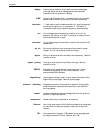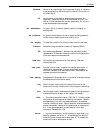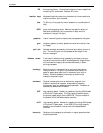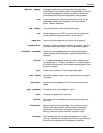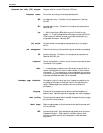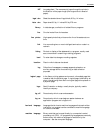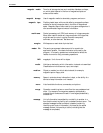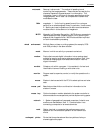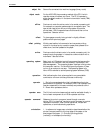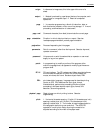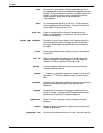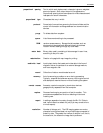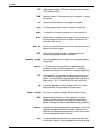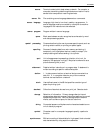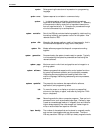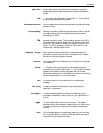
GLOSSARY
GLOSSARY-14 XEROX 4635 LASER PRINTING SYSTEM INSTALLATION PLANNING GUIDE
object file Source file converted into machine language (binary code).
object mode For the 4635 LPS, the processing method of the PC UI which
uses the mouse, windows, and icons. The PC UI operates in
either the object mode or in the terminal emulation mode (TEM).
See also TEM.
offline Devices not under the active control of a central processing unit.
For example, a computer makes output to a magnetic tape. The
tape is then used by an offline printing system to produce
printed data. Offline operations are much slower than online
operations. See also online.
offset To place pages currently being printed in slightly different
positions from previous pages.
offset printing Widely-used method of commercial and corporate printing,
where ink is picked up by a metal or paper plate, passed to an
offset drum, and then passed to the paper.
online Devices under the direct control of a central processing unit, for
example a printing system in interactive communication with a
mainframe. See also offline.
operating system Basic host- or LPS-resident controlling program that governs the
operations of a computer, such as job entry, input/output, and
data management. The operating system is always running when
the computer is active. Unlike other types of programs, it does
not run to an end point and stop. The operating system of a
Xerox LPS is referred to as the operating system software (OSS).
operation Well-defined action that, when applied to any permissible
combination of known entities, produces a new entity.
operator 1. Part of a process description that indicates the action to be
performed on an operand. For example, ADD is an operator that
uses two operands (in this case numbers) and produces a third.
2. Person who operates a device.
operator area The 24-inch exclusive clearance that must be available directly in
front of each component of an LPS for operator activities.
operator command Statement to control a program, issued through a console
device, PC UI, or terminal, causing a control program to provide
requested information, alter normal operations, initiate new
operations, or terminate existing operations.
orientation 1. In reference to image area, orientation describes whether the
printed lines are parallel to the long edge of the paper or the
short edge of the paper. 2. Choice of printing portrait
(vertically) or landscape (horizontally).



